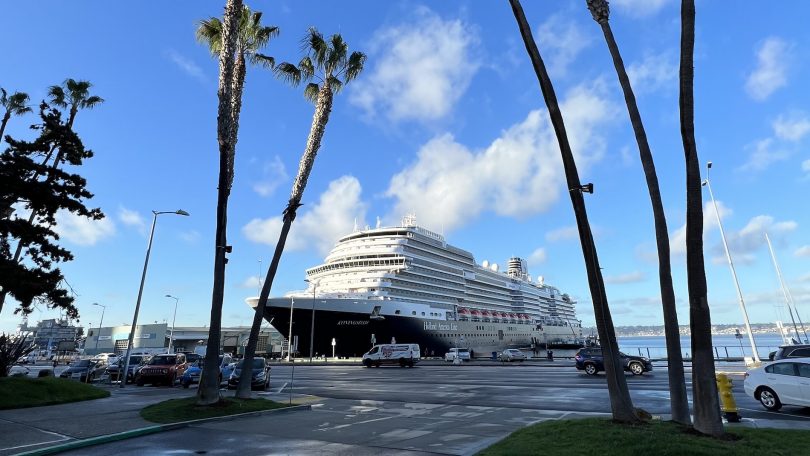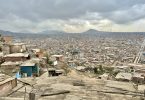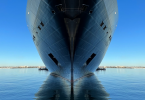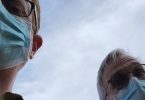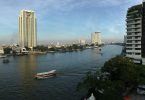Clyde and I are fully vaccinated. We’ve had our booster shots. We wear our masks in public spaces (even when doing so isn’t cool). We wash our hands. We don’t smooch with strangers.
But despite these precautions, at some point between our negative test on December 24th and our positive test on December 28th, we managed to inhale that microscopic ball of spiky proteins that causes COVID.
And so, like millions of others with “breakthrough cases,” we’ve now got scratchy throats and annoying coughs. But unlike most of those millions, we’re among a small number of passengers and crew who have tested positive while on vacation aboard Holland America’s Koningsdam.
This is the travel post I never wanted to write: What To Expect When You Get COVID on a Luxury Cruse.
Mundane Beginnings
We leave home for San Diego on Christmas Day, securing our N95 masks on our faces and removing them only briefly to sip ice water or nibble one of Delta Airlines’ crunchy Biscoff wafers.
By ten o’clock PST, we are snug in our bed at the Wyndham Bayside, a hotel we chose because it lies directly across the street from the pier where the Koningsdam docks.
For us, that convenience offsets the fact that the rooms are small and the walls are thin — thin enough, in fact, for us to hear every single time the man in the neighboring room coughs and hacks and wheezes.
At one point, after the poor fellow sounds like he he just coughed up his own testicles, Clyde opens the door to the room’s tiny patio so we’ll have more fresh air.
Cruising During COVID
This is not our first COVID-era cruise.
In August of 2021, we snagged the Pinnacle Suite — the largest and most luxurious room — aboard Holland America’s Eurodam.
At the time, three things kept our COVID-related fears at bay. First, the European Union’s COVID protocols demanded that every single person on the Eurodam would be tested before being allowed to board and again at the end of the cruise. Second, while rates of COVID infection were high in Greece, they were significantly lower than back home in Union County, Mississippi. And third, while mask-wearing had fallen out of fashion back home, folks in Greece were obsessive about masking up.
While in one of the ports, we heard from other cruise ship passengers that a Norwegian cruise ship traveling alongside ours had canceled ports and locked all passengers in their rooms due to a spike in COVID cases on board. But to our knowledge, no one on Holland America’s Eurodam got sick.
The key phrase there, though, is “to our knowledge.”
Today, there are several passengers and crew aboard the Koningsdam who have tested positive, including us. We are all housed in an isolation corridor on the 4th level of the ship. Outside that corridor, a subtle sign notes this area is designated as a quarantine zone. Along the corridor, every room door is emblazoned with a paper sign warning people to stay away.
But because there have been no announcements, I doubt few, if any, of our fellow passengers know we’re here, or that COVID is making the rounds.
You’re Not in the EU Anymore
Sunday morning, by virtue of our frequent-sailing status on Holland America, Clyde and I are among some of the first to board the Koningsdam.
In Greece, small groups of us were herded into testing tents. Technicians stuck cotton-tipped swabs a good eighteen feet up into our nostrils and stirred our sinuses like brownie batter before dipping the resulting sample into plastic vials.
Each of us were given a number. If your number appeared on a video screen, you were free to proceed. If your number didn’t come up, a COVID SWAT team descended on you, ushered you out of the tent, and spent the next fifteen minutes spraying everything you could have touched with disinfectant.
In San Diego, we are surprised to find ourselves in one huge warehouse along with hundreds of other passengers. Everyone is masked, but we are immediately wary, as this is the largest crowd we’ve been in since COVID began.
The long “Health Assessment” line snakes around and around the room’s interior. It moves very slowly. Even if you hang back in line to distance yourself from the people ahead, the people in the lines to your left and right are never more than a foot or two away.
When we balk a bit, a sweet-voiced person in a Holland America mask tells us, “Try your best to maintain a little social distance.”
I’m not sure whether he’s giving me advice … or issuing a Squid Games-style challenge: “Try your best to maintain social distance. Players who fail to do so will be eliminated.”
Trouble in Paradise
Once on board, we snag a welcome upgrade to our favorite kind of room and the best value on the ship: a Neptune Suite … the “double wide trailer” of cruise ship cabins.
This is the room where we spend a happy night after our first day at sea. This is the room where I wake up on Monday morning, take a seat on the balcony, and work on my novel. This is the room where friends come to visit in the afternoon, sharing a glass of champagne while chatting about plans for the coming day.
This is the room where, Monday evening, I first start to feel a little off: a little tired, a little dull. This is the room Clyde returns to when, at dinner, he’s suddenly too nauseous to face his shrimp cocktail appetizer. This is the room where we wake up on Tuesday morning, throats scratchy and sore.
Foreshadowing!
On Monday afternoon, as we make our way down the staircase from our room on the seventh floor to the dining room on level two, our progress is interrupted by a stern-faced man in security garb.
“If you don’t mind, sirs,” he says. “Please go back up a level and take the elevators. We’ve had a medical incident on this floor. We’ve sprayed the area with disinfectant, but we have to wait five minutes before anyone can be allowed to come through.”
We comply. I look at Clyde. He looks at me. No one has said the word “COVID,” but what other kind of “medical incident” would require spraying a staircase and elevator lobby down with an anti-viral mist?
We take the elevator down. When we board, three other masked passengers squeeze into the tiny lift, a bit too close for comfort. Just as the doors close, a woman on a Rascal scooter barges into our midst and forces everyone to stand shoulder to shoulder — or, in some cases, face to face — in order to accommodate her.
“Come on, come on,” she bellows at her three elderly friends who remain in the lobby. “Plenty of room!”
“There’s no more room,” I say firmly, earning myself a glare from Rascal Lady — but the other passengers loudly agree.
Later the same day, as we return to our room, the previously secured and disinfected elevator lobby is open again. It’s here that, for the first time, I notice the shuttered corridor adorned with a subtle sign: “Quarantine Area. Authorized Personnel Only.” I pause there, wondering what life is like on a cruise ship’s quarantine ward.
In less than twenty-four hours, I’ll know.
COVID Creeps in on Little Cat Feet
I’ve wasted a lot of time wondering where got exposed.
Did we get COVID on the plane, from the man who had to be reminded more than once to keep his mask up? Did we get it at the hotel, from the coughing man next door? Did we get it in the hotel restaurant, when we took our masks down to eat cheese sticks and pot pies?
Did we get it Sunday morning during our breakfast on the pier, when we sat near a tight-knit group of crew members from the Koningsdam who whispered about an outbreak on the ship just before it docked in San Diego? Did we get it from a fellow passenger in the health screening line?
Did we get it from any of several unmasked passengers at the tables around us in the Koningsdam‘s massive dining hall? Did we get it from gripping staircase handrails and mindlessly swiping at our nose with those same fingers a minute later?
We’ll never know. Wondering about it is pointless.
The Responsible Thing
On Tuesday morning, Clyde’s coughing. I’m coughing, too, and feeling decidedly less healthy than I did the day before.
“Do you think it’s COVID?” I ask.
Clyde shakes his head. “I don’t feel like it could be.”
We sit in silence, weighing the decision.
I can feel the seductive comfort of Clyde’s subjective appraisal. It is human nature to dismiss, to normalize, to cling to routine, to stick with the plan, to stay the course.
But on the other hand: Clyde and I have been very critical of people around us who have failed to do responsible things. They’ve avoided vaccination. They’ve refused to wear masks. They’ve gone to large public events and, later, admitted that they did so, even though knew they were feeling feverish at the time.
A year ago, before the vaccines, we gave in to social pressure and allowed someone to visit us in our home despite his refusal to wear a mask. We knew he’d recovered from COVID many weeks before, but what we didn’t know, because he didn’t disclose it, was that he was still testing positive … and that he was the kind of person who would come into a high-risk person’s home despite that fact.
Clyde got COVID shortly after that. By sheer luck, Clyde’s case was asymptomatic, and I somehow avoided the virus entirely. But things could have been much worse … and, given how careful we’d been otherwise, I’ll always believe we have that irresponsible young man to thank for Clyde’s infection.
So: on the one hand, we could go on with our vacation. After all: we don’t feel that sick. We could say nothing. We could mask up. We could shop in Cabo, grab a taco or two, see the sights, hope for the best.
But on the other hand, we think about the friends we’re traveling with … the other passengers we might infect … and the harsh things we’ve had to say about those who have refused to do the right thing, the responsible thing, the Christian thing in situations much like these.
With heavy hearts, we call the ship’s medical officer and say we need to be tested.
Testing and Results
Despite our intention to be ethical and responsible, that call to the ship’s medical officer is fraught with uncertainty and fear.
If we tested positive … would we be put off the ship in Mexico and left to fend for ourselves? Would we be sequestered in our spacious Neptune Suite? Would we be bagged up and dragged to a windowless interior room for the remainder of the voyage?
The officer listens to our symptoms, directs us not to leave our room, and sends a member of the medical staff to test us. He arrives in full protective gear: face shield, mask, gloves, plastic apron, booties.
He stands as far from us as possible, drawing near only when taking blood pressure. When he asks us to drop our masks for the nasal swab, he has us turn to the left to avoid exposure when we exhale.
“If you test negative,” he tells us, “you’ll still have to stay here in your room for the next twenty four hours. If you test negative again, you’ll be allowed to continue enjoying the cruise.”
I blink. “And if we test positive?”
The medic shrugs. “You’ll be isolated for the rest of the trip, but I don’t know all the details of that.”
Forty-five minutes later, we get a call. We’ve both tested positive.
The COVID Portion of our Cruise
After testing positive on board a Holland America cruise ship, a chain of events unfolds over which we, as guests, have very little control.
At first, we’re just told to stay in our room. I envision us spending the rest of our trip sequestered here in our Neptune Suite: a 500+ square foot space with a largish seating area, wide balcony with lounge chairs and a card table, and a spacious bath. Staying in this room for six days straight wouldn’t be optimal … but feels doable.
But the customer service agent who calls us next very politely informs us that we’ll be moving from this room to a room on the quarantine floor. We have thirty minutes to pack before porters will appear to ferry our suitcases down to our new abode.
This spooks me a bit, as I picture us squeezed into a windowless inside room — but the agent assures me that all quarantine rooms have a verandah. But the next bit of information really bothers me: there is a chance, I’m told, we’ll be housed in separate suites.
Some people thrive on seclusion; I’m not one of them. Spending six days alone and locked in a cruise ship cabin is pretty much my idea of a personal hell. I imagine the crew opening the door six days later, only to find the mattresses ripped open, the walls covered with a manifesto I’ve scrawled with my own blood, and the mirrors smeared with esoteric diagrams I’ve drawn with my own excrement.
The next call confirms that we’ll be housed together.
Riding the COVID Railroad
The transfer team arrives at our door: a nurse in full protective gear and a steward decked out in a white hood, white body suit, white astronaut gloves, and white booties. The rectangular plastic window in the hood shows us nothing but his eyes, which are wide with fear.
We scoop up our belongings (our luggage is sprayed with anti-viral mist) and are herded into the deserted seventh-floor corridor. Security guards stand at the ends of the hall and glance furtively in all directions, as though we’re engaged in some kind of covert operation.
We’re herded quickly toward an elevator bay, where another white-suited team stands at the ready with canisters of anti-viral disinfectant. We’re instructed to get into the elevator, take it to the fourth floor, and wait. Before the doors even close, the team starts pumping the air full of sterilizing fog.
On level four, a security officer and another disinfectant team await. They hold us there — are they afraid we’ll make a run for it? — until our nurse and steward arrive.
The mysterious bulkhead doors, closed just hours earlier, are open now. We’re guided through these and into a long corridor lined with locked cabins, each of which has a short stool outside. After walking what seems a long way — how many people on this ship have COVID? — we are ushered into our new room.
Ironically, this isolation room is the exact room class we booked, but escaped via a paid upgrade: a verandah-class room with what Holland America euphemistically calls “a partially obstructed view.” (Translation: a rack of RV-sized lifeboats dangles just beyond the verandah’s handrails.) This room — where we will spend the next six days together — is about half the size of our Neptune Suite: approximately 250 square feet, including the verandah.
Life in the Isolation Ward
As I write this, we’ve been here not quite 24 hours. Yesterday, we could see the resort-littered shores of Cabo San Lucas; today, we can glimpse the palm-studded beaches of Mazatlan just beyond the tops of the life boats outside our window.
Holland America’s customer service team has been in touch. For each day we spend in isolation, we’re being given cruise credits to spend on future cruises. The money we invested in our cabin upgrade and on reservations for two New Year’s gala events has been refunded. While we’ll pay nominal charges for the drugs we’re taking, our medical care is otherwise free.
Even in isolation, we have access to 24-hour room service. A couple of menus (burgers, sandwiches, even some steaks) are always available, or we can order from the main dining room when meals are being served. During certain times of day, we also have access to a limited menu of items from some of the ship’s fancier restaurants.
Our meals come in disposable paperboard boxes and paper cups, accompanied by paper napkins and wooden sporks. They arrive about 45 minutes after we order them, dropped off by masked attendants who hustle away after dropping the trays off on the stool outside our door.
During our first day here, someone would also leave a mysterious meal — a chicken breast, usually, or rice and sauced veggies — on our stool. After thinking about it, we’re pretty sure these are the meals served to quarantined crew members (who don’t have, apparently, the luxury of choosing their own meals from the room service menu).
When we eat, we gobble down our food while sitting together on the narrow little love seat. When we’re done eating, we place empty trays and trash on the stool outside our door. At this point, there’s a lot of trash out there, despite repeated calls to have it collected. Apparently, the housekeeping crew doesn’t have anyone assigned to full-time quarantine trash collection.
Speaking of housekeeping: we don’t get any for the duration of our stay. Our new cabin has been stocked with piles of towels and rolls of toilet paper meant to last us for the next six days. (If the trash overflows, we’re told, we can call for someone to empty it.) As we do at home, we make our own bed and clean our own bathroom.
We’ve been told we can even send out laundry — though we’ve also been told it will be washed in 180-degree water, which will likely shrink and destroy any “delicate items.”
We’ve bought Holland America’s “Premium Streaming Internet Package,” which, it turns out, is optimistically named. Our connection is fine for tweeting or downloading email, but any attempt to stream anything — including low-resolution YouTube streams — is an exercise in frustration.
Living Large in 250 Square Feet
We pass our time, then, wandering the cabin. I sit on the bed awhile, and then in the little desk chair, and then on the love seat, and then on the chaise lounge on the verandah … and repeat. I read. I write. I check social media. I read some more. I write some more. I check social media … again.
As far as COVID goes, things are about as good as they can be. Our throats are still sore, and our coughs persist … but otherwise, at least today, apart from some minor stuffiness, we feel fine.
We dutifully log our temperature, taken twice daily with a little gun the crew supplied. We receive two calls a day from medical staff, asking how we’re feeling and assuring us we can ask for any medications or supplies we need.
We’re in good spirits. We’re fortunate, I think, to be one of those couples that spends a lot of time together anyway. Upon reflection, our thirteen years together in a small Midtown Atlanta condo and our year in a tiny cabin in the Mississippi woods feel a bit like dress rehearsal for the show we’re in now.
And now, if you’ll excuse me, I’ve booked a spa treatment: a luxurious hot shower in our cramped little bathroom. After that, I plan to attend a meditation session on the balcony, followed by a jog-in-place workout to get my heart rate up. This afternoon, I’ll take in a movie or show I downloaded to my iPad before we left home. (At the time, I remember thinking, “I’ll get these just in case we get quarantined … ha ha!”)
Meanwhile: if you have questions about life in the quarantine zone of a luxury cruise ship, please feel free to drop them to me at mark@markmcelroy.com or via Twitter @MarkMcElroy.
I promise you: I would welcome the distraction.

